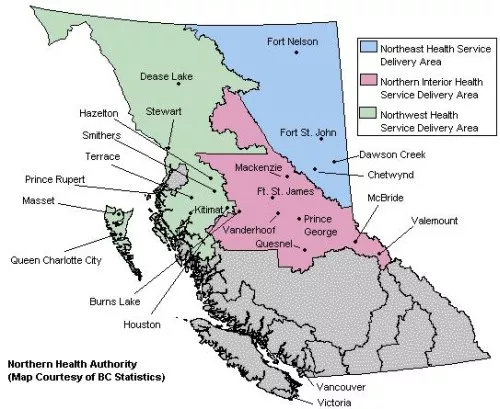
On This Page:
- The Determinants of Health in Northern, Remote, and Rural British Columbia
- Canadian Social Determinants of Health
- Health and Gender
- Health, Gender and Context: The Northern Health Region
- Health, Gender, and Northern Factors
The Determinants of Health in Northern, Remote and Rural British Columbia
This section highlights some of the unique challenges that women living in northern, remote, and rural areas of the province are faced with when maintaining their health. A research paper prepared by the Northern Secretariat of the BC Centre of Excellence for Women's Health titled 'The Determinants of Women's Health in Northern, Remote and Rural Regions: Examples and Recommendations From Northern British Columbia' finds that women from these areas need to actively be included in health policy and practice changes. A recent literature review in 2016 by Karleigh Smith finds that despite progress the health disparities faced by northern women persist.
Be sure to explore the research and publications page for information on a variety of health-related topics and more detailed discussions.
Canadian Social Determinants of Health
The Public Health Agency of Canada (2020) has identified 12 key determinants of health. Determinants of health are the broad range of personal, social, economic and environmental factors that determine individual and population health. The main determinants of health include:
Income and Social Status: The key factor that determines health status. Likewise, social status affects health by determining the degree of control people have over life circumstances and, hence, their capacity to take action.
Employment and Working Conditions: Meaningful, non-precarious employment, economic stability, and a healthy work environment are associated with good health.
Education and Literacy: Meaningful and relevant education equips people with knowledge and skills for daily living, enables them to participate in their community, and increases opportunities for employment.
Childhood Experiences: Positive prenatal and early childhood experiences have a significant effect on subsequent health.
Physical Environment: Factors such as air and water quality, the type of housing and the safety of our communities have a major impact on health.2. Social Support Networks: Support from families, friends and communities is important in helping people deal with difficult situations and maintaining a sense of mastery over life circumstances.
Social Support and Coping Skills: Support from families, friends and communities is important in helping people deal with difficult situations and maintaining a sense of mastery over life circumstances. The health of individuals and communities as a whole is strongly influenced by the values and norms supported by their geographical area. Effective coping skills enable people to self advocate, connect with community supports, solve problems and make choices that enhance health.
Healthy Behaviours: Personal health practices can be helpful in preventing diseases and promoting self-care
Access to Health Services: There is a relationship between the availability of preventive and primary care services and improved health (e.g., well baby and immunization clinics, education programs about healthy choices).
Biology and Genetic Endowment: Recent research in the biological sciences has shed new light on "physiological make-up" as an important health determinant.
Gender: Transgender, cisgender, intersex, and gender non-conforming individuals face different health challenges at different ages. In addition, literature has demonstrated that gendered norms impact individual health as well as the health system's practices, policies and priorities.
Culture: Dominant cultural values both directly and indirectly contribute to issues of discrimination, marginalization, stigmatization and devaluation of other cultures. The can result in additional barriers to culturally appropriate health care and services.
Race / Racism: Experiences of discrimination, racism, and historical and ongoing trauma are important social determinants of health for certain groups such as Indigenous Peoples, Black Canadians, and all People of Colour.
References
The Public Health Agency of Canada (2013). Underlying Premises and Evidence Table. Retrieved from: Government of Canada Social determinants of health and health inequities
Health and Gender
Men's and women's good physical and mental health is associated with several of the same factors, such as: higher socio-economic status, higher education level, social inclusion, and maintaining a healthy lifestyle (Turcotte, 2011). Similarly, both men's and women’s health is negatively impacted by many of the same environmental (e.g., air quality, disease epidemiology) (Giesbrecht, Cinnamon, Fritz, & Johnston, 2014) and social factors, (e.g., unemployment, food insecurity) (Mikkonen & Raphael, 2010). Regardless of these similarities, research demonstrates that Canadian women have an adverse experience with social determinants of health relative to men. Therefore, this results in lower health status in women. Some of the social factors that affect men’s health have an even more detrimental effect on women’s health: for example lower education level and lower socio-economic status (Bushnik, 2016). Health determinants for men and women interact with individual characteristics and social factors such as:
- Race,
- Ethnicity,
- Sexual orientation,
- Marital status,
- Religion,
- Disability,
- Medical conditions, and
- Several more individual characteristics and social factors.
It is important to note that these factors are not evenly distributed between men and women, nor between groups of women. Certain aspects of a person’s identity (e.g., Aboriginality, sexual orientation, elderly, disability, and substance dependence) may cause the individual to experience considerable marginalization that can potentially compound and thus deepen the effects of the social determinants.
One factor that is often overlooked and impacts women's health is physical, sexual, and emotional violence. In Canada, approximately 51 percent of adult women report having experienced some form of violence personally at some point in their adult lives (Sen, 2016). While measures have been taken in Canada to address the issue of violence against women, it continues to be a serious and consistent problem that is affecting communities countrywide.
Note that the factors that influence a woman’s health may not be consistent over time. All of the factors mentioned above have a role in determining an individual’s health status by influencing behaviour and constraining women’s choices and access to health care. These factors affect a woman’s available time, resources, knowledge, self-esteem and physical capabilities to actively engage in healthy behaviours and lifestyle choices for her and her family. For instance, what lifestyle a woman can enjoy and therefore, how much exercise and access to healthy foods she has, is dependent upon her employment, income, education level, social responsibilities and what her community has to offer geographically.
Similar to how gender has such a strong impact on health care and health status, geographical location also holds an influential role. Therefore health care planning, implementation and policies need to be responsive to the diversity of women as well as responsive to the geographical location where these women reside.
References
Bushnik, T. (2016). The health of girls and women. Statistics Canada, Catalogue no. 89-503-X.
Giesbrecht, M., Cinnamon, J., Fritz, C., & Johnston, R. (2014). Themes in geographies of health and health care research: Reflections from the 2012 Canadian Association of Geographers annual meeting. The Canadian Geographer 58(2), 160-167.
Mikkonen, J., & Raphael, D. (2010). Social Determinants of Health: The Canadian Facts. Toronto, Canada: York University School of Health Policy and Management.
Sen, P. (2016). Development and Violence against Women. Gender and Development, 6(3), 7-16.
Turcotte, M. (2011). Women in Canada: A gender-based statistical report. Statistics Canada, Catalogue no. 89-503-X.
Health, Gender and Context: The Northern Health Regions
Current literature demonstrates that the Canadian health sector continues to overlook the unique needs of northern, rural, and remote communities, therefore forcing residents of these communities to take additional steps and/or incur additional costs to receive the same level of health care as those who live in southern Canada. All women living in northern, rural, or remote communities are in a more vulnerable position in regards to health status and health care because their geographical position intensifies and compounds social determinants. For example, resource-based communities (often found in the north) have unstable, fluctuating economies, and less accessible higher education opportunities. In regards to British Columbia, regions within the Northern Health Authority are particularly susceptible in this regard.
These health service delivery areas have to face the barrier of accessibility, as there are several remote communities in this area. For a visual representation of these areas refer to Map 1. For instance, the communities of Tsay Keh Dene and Kwadacha, north of Williston reservoir, are accessible only by plane when the gravel runway is in good condition (either frozen or dry). Additionally, northern British Columbia is home to a number of towns that once relied on the mining industry to provide local services, with many now relying on oil and gas. Many of these communities have to continuously fight to maintain a health care infrastructure for residents. These are just some examples of what additional barriers affect health care, health access and health status in the north
Map 1. Service Delivery Areas of Northern Health

Note. Photo of regions under the Northern Health Authority. Map is Courtesy of B.C. Statistics.
Health, Gender, and Northern Factors
In addition to the compounding effect of gender and geography on the social factors that affect women’s health, there are further geographical factors that are particular to northern, rural regions of the province. The Northern Secretariat in northern British Columbia determined through research and outreach initiatives (1999-2000) that these northern factors include:
- Isolation (both physical and emotional),
- Transient population,
- Harsh climate,
- Substandard, limited or non-existent services,
- Limited access,
- Transportation,
- Low population sometimes problematically used as a basis for determining public investment in needed services and;
- Seasonal employment/fluctuating resource-based economies which bares significant social explanations.
This was a brief summary of some key points about women's health in the north. For further discussion, please see our Northern Factors' and Women's Health page.